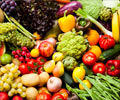
‘To ensure a sufficient and sustainable food supply, the EC2020 app along with other technological developments, will be supported in the future by the project team and the global research community.’
Read More..Tweet it Now
According to IIASA researchers, there is currently no remote sensing based global data set of the spatial distribution of the world’s staple crops. Citizen science provides an opportunity to improve this situation. The Earth Challenge 2020 (EC2020) aims to use citizen science to address major environmental issues such as air pollution and food supply. The involvement of citizens is fostered, among others, through the EC2020 app that features several thematic widgets.Read More..
The newly developed food supply widget will ask volunteers to interpret and label different photographs of six major crop types, with the goal being to use citizen science to interpret and annotate crops in different photographs from around the globe using street level photography. In addition to advancing work on food security and preparing for the increasing global population amid climate change, this campaign will help clarify the contributions that citizen science can make to Earth Observations, and vice versa.
“Currently much of the best information we have at hand on crop species distribution globally is derived from models. This includes data from the Food and Agriculture Organization of the United Nations (FAO) and the Spatial Production Allocation Model (SPAM). The SPAM data, for example, is provided at 10 km resolution for 42 crops. While this data provides a comprehensive set of information for the modeling community, the research community and policymakers require a much finer level of detail, both spatially and temporally,” explains IIASA Ecosystems Services and Management Program researcher Ian McCallum.
This innovative citizen science approach to labeling street-view photography for crop types will be linked to the global Earth Observation archives through the Euro Data Cube platform. This ESA funded activity provides the environment for linking the citizen interpreted information with automatically derived agricultural parcel boundaries. Together these provide the essential inputs to machine learning approaches that allow deriving high resolution crop type maps over large areas.
“Spatially explicit information on agricultural crop types is an essential prerequisite for many follow-up investigations, for example, on environmental impacts of food production or the effectiveness of agricultural policies and legislation. Earth Observation is the key tool to generate this type of information. While the availability and quality of the necessary Earth Observation data has greatly increased over the last years, for example, through the Copernicus program and the Sentinel satellites, the lack of reference and training data is hindering many innovative applications. Once in place, this workflow will allow generating training data in a highly automated manner and for efficiently linking up with Earth Observation data and machine learning technologies. Today’s release of the widget is a first crucial step towards that goal,” says Patrick Griffiths, the involved scientist from the Directorate of Earth Observation at ESA.
Advertisement
The team says that reference data for crop types is currently one of the biggest issues discussed within international science and policy communities focused on Earth Observation, such as the Group on Earth Observations’ GEOGLAM initiative. The campaign will aid in the labelling of crop types (potentially going back some years, as Streetview also has historical images) and hence the production of an unique and massive global crop type reference database of the globally very important crops such as wheat, maize, sunflower, rice, sorghum, and soya, among others, which will improve crop type mapping tremendously.
Advertisement
It is anticipated that these technical developments including the Picture Pile app widget and the training data generation workflow and services in the Euro Data Cube platform will be leveraged in the future by the project team and the global research community to help ensure global food supply is both sufficient and sustainable.
Source-Newswise















